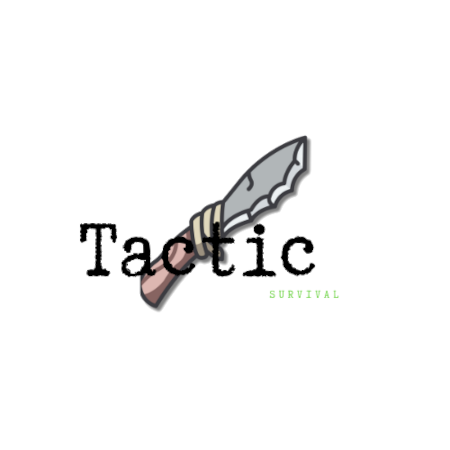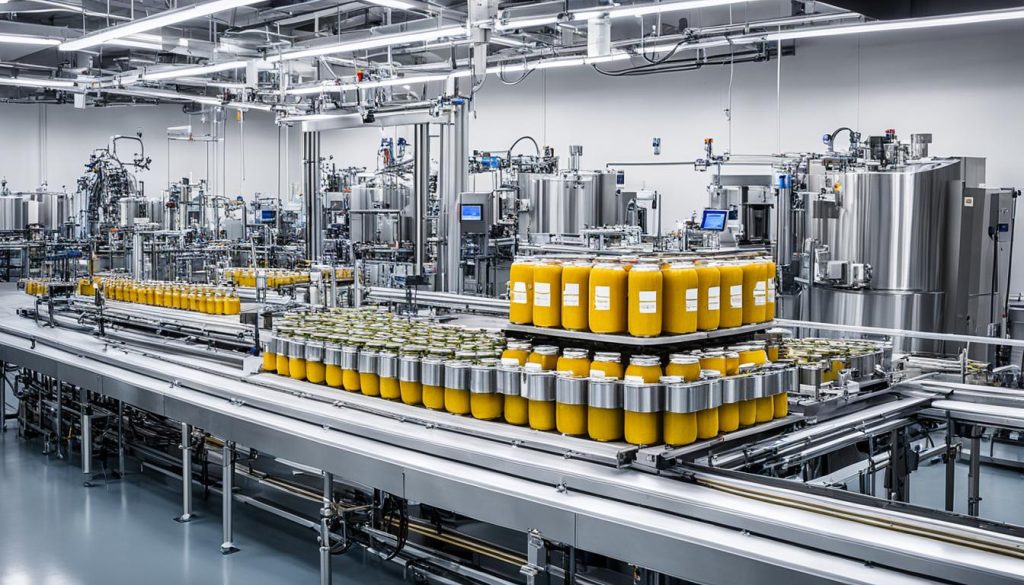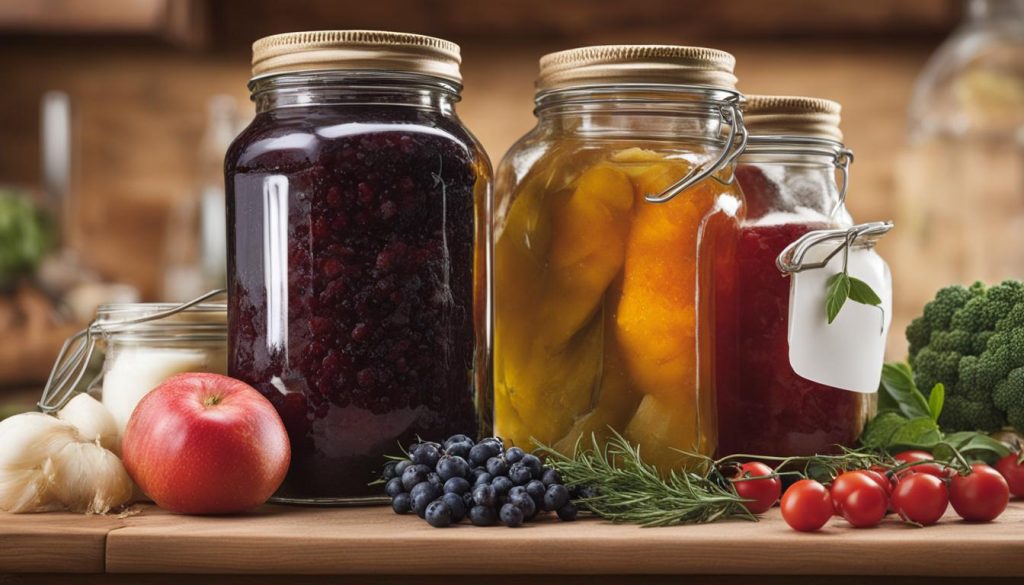Did you know that advanced canning techniques can extend the shelf life of food up to five years or more? That’s right! Whether you’re a seasoned canner or just starting out, learning how to preserve food using advanced canning techniques is a valuable skill that can ensure your pantry is stocked with nutritious and delicious food throughout the year.
Key Takeaways:
- Advanced canning techniques can significantly extend the shelf life of food, allowing it to be stored for up to five years or more.
- Learning and practicing advanced canning techniques can provide you with a reliable source of readily available and high-quality food throughout the year.
- With the right tools, knowledge, and adherence to safety standards, you can confidently practice advanced canning techniques and enjoy the benefits of long-term food preservation.
- Understanding the differences between low-acid and high-acid foods is essential in determining the appropriate canning method for optimal preservation and safety.
- Staying informed about the latest canning innovations and following recommended guidelines ensures the safety and quality of your canned goods.
Tools and Techniques for Advanced Canning
To successfully practice advanced canning techniques, it is important to have the right tools and knowledge. The U.S. Department of Agriculture’s Complete Guide to Home Canning is a valuable resource that provides comprehensive information on canning safety standards and techniques.
When it comes to canning, having the right equipment is essential. Here are some must-have tools for advanced canning:
- Canning Jars: Choose sturdy, high-quality glass jars specifically designed for canning. Mason jars are a popular choice, as they come in various sizes to accommodate different types of food.
- Lids and Rings: The two-piece metal lids and rings are used to create an airtight seal on the jars. It is important to use new lids for each canning session to ensure a secure seal.
- Water Bath Canner or Pressure Canner: The type of canner you need depends on the acidity level of the food you’re canning. A water bath canner is suitable for high-acid foods, while a pressure canner is necessary for low-acid foods to eliminate the risk of bacterial growth.
- Jar Lifter: This tool is specially designed to lift hot jars in and out of the canner, ensuring safe handling.
- Canning Funnel: A wide-mouthed funnel helps in pouring hot liquids into jars without spills or wastage.
Proper sterilization of equipment is vital to maintain the integrity of canned foods. Before starting the canning process, ensure that the jars, lids, and rings are in good condition and free from any cracks or damages. Wash them with hot, soapy water and rinse thoroughly.
Working quickly is essential during the canning process to keep the food and jars hot. This helps maintain the temperature necessary for proper sealing. Be sure to leave the appropriate headspace in the jar to allow for expansion during processing and to ensure a proper vacuum seal.
Expert Tip:
Remember to follow the manufacturer’s instructions for all canning equipment to ensure safe and successful results.
By using the right tools and techniques for advanced canning, you can confidently preserve and store your favorite foods for an extended period.
Tips and Tricks for Successful Canning
Following these tips and tricks can help ensure successful canning every time.
- Gather and check your equipment: Before starting the canning process, gather all your canning equipment and ensure it is in good condition. This includes canning jars, lids, rings, a water bath canner or pressure canner, a jar lifter, and a canning funnel.
- Keep jar exteriors clean: If you have hard water, adding distilled vinegar to the water bath can help keep the jar exteriors clean during the canning process.
- Sterilization: While sterilizing the jars, lids, and rings in advance may not always be necessary, it is important to follow the processing time guidelines. Ensure the processing time is at least 10 minutes to effectively kill any bacteria or spoilers.
- Working quickly: Work quickly to fill the hot jars with your preserved food and properly tighten the rings. This helps maintain the desired heat levels and ensures a proper seal.
- Post-canning storage: After the canning process, it is recommended to remove the rings from the jars and store them in a cool, dark place. This optimal storage environment helps preserve the quality and longevity of your canned goods.
Quotes:
“Gather and check your canning equipment before starting the canning process.”
“Adding distilled vinegar to the water bath can help keep the jar exteriors clean.”
Canning Guidelines:
| Canning Tips | Safety Standards | Canning Process | Canning Guidelines |
|---|---|---|---|
| Gather and check your equipment | Follow proper sterilization procedures | Work quickly to fill the hot jars | Remove rings and store jars in a cool, dark place |
| Keep jar exteriors clean | Ensure jars, lids, and rings are in good condition | Properly tighten the rings | |
Canning Innovations and Safety Standards
Over the years, canning has advanced significantly, thanks to continuous innovations in canning technology. These innovations have led to improved safety standards and processes in the industry, ensuring the safety of canned foods for consumers.
The modern canning industry adheres to strict guidelines and regulations to guarantee that the canned foods we consume are safe and of high quality. Commercial canning processes now employ advanced equipment and techniques to achieve optimal heat penetration and proper sealing, reducing the risk of spoilage and contamination.
For home canners, staying up-to-date with the latest safety standards and techniques is crucial. By following the recommended guidelines, you can effectively prevent the growth of harmful bacteria and ensure the safety of your preserved foods. The U.S. Department of Agriculture’s Complete Guide to Home Canning is an invaluable resource that provides comprehensive information on canning safety standards and techniques.
By embracing canning innovations and adopting proper safety standards, you can confidently preserve food at home while maintaining its nutritional value and quality.
The above image depicts the technological advancements in canning, showcasing the progress made in ensuring the safety and longevity of preserved foods.
Canning – To learn more about the history and process of canning food processing, click here.
Low-Acid Preservation and High-Acid Foods
Understanding the differences between low-acid and high-acid foods is crucial in determining the appropriate canning technique. High-acid foods, such as fruits, tomatoes, and pickles, can be safely preserved using a water bath method. Low-acid foods, such as meats, seafood, and vegetables, require the use of a pressure canner to reach the necessary temperature for preservation. It is important to follow the recommended canning times and processes for each type of food to ensure their safety and quality.
When canning high-acid foods, the water bath method is an effective technique. This process involves submerging sealed jars in boiling water and heating them to a specific temperature to kill bacteria, yeasts, and molds that could spoil the food. The high acidity of these foods creates an environment that inhibits the growth of harmful microorganisms, making water bath canning a safe preservation method.
On the other hand, low-acid foods have a pH level higher than 4.6, making them more susceptible to the growth of harmful bacteria like Clostridium botulinum. To ensure their safety, low-acid foods must be processed at temperatures higher than what can be achieved with a boiling water bath. This is where a pressure canner comes in. The pressure canner uses high-pressure steam to reach the necessary temperature of 240°F (116°C), which is required to destroy harmful microorganisms and toxins in low-acid foods.
It is important to note that using the wrong canning method for low-acid foods can result in bacterial growth and the production of toxins that can cause serious illness. Therefore, following the recommended canning times, processes, and equipment for each type of food is vital to ensure the safety and quality of the canned products.
By understanding the differences between low-acid preservation and high-acid preservation, you can confidently choose the appropriate canning technique for different types of foods. Whether you’re preserving your garden harvest or preparing homemade sauces and spreads, proper canning techniques will help you safely enjoy these preserved foods for months or even years to come.
| Low-Acid Foods | High-Acid Foods |
|---|---|
| Meats | Fruits |
| Seafood | Tomatoes |
| Vegetables | Pickles |
Conclusion
Advanced canning techniques offer a reliable solution for long-term food preservation. By adhering to safety standards, utilizing the right equipment, and staying updated on the latest canning innovations, you can confidently stock your pantry with high-quality, shelf-stable food. With proper techniques and storage, you can extend the lifespan of your canned goods, ensuring you have a constant supply of nutritious and delicious food throughout the year.
Whether you’re an experienced canner or just starting out, following canning tips and guidelines is essential for successful preservation. By mastering advanced canning techniques, you can unlock the benefits of long-term storage, including reduced waste, convenience, and the ability to enjoy home-preserved foods at any time. By understanding the differences between low-acid and high-acid foods and selecting the appropriate canning method, you can preserve a wide range of ingredients for future use.
Make the most of advanced canning techniques to preserve the flavors of each season and create a well-stocked pantry. By embracing this time-tested method of food preservation, you can enjoy the satisfaction of self-sufficiency and the peace of mind knowing that your favorite ingredients are always at hand.


